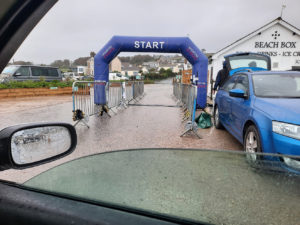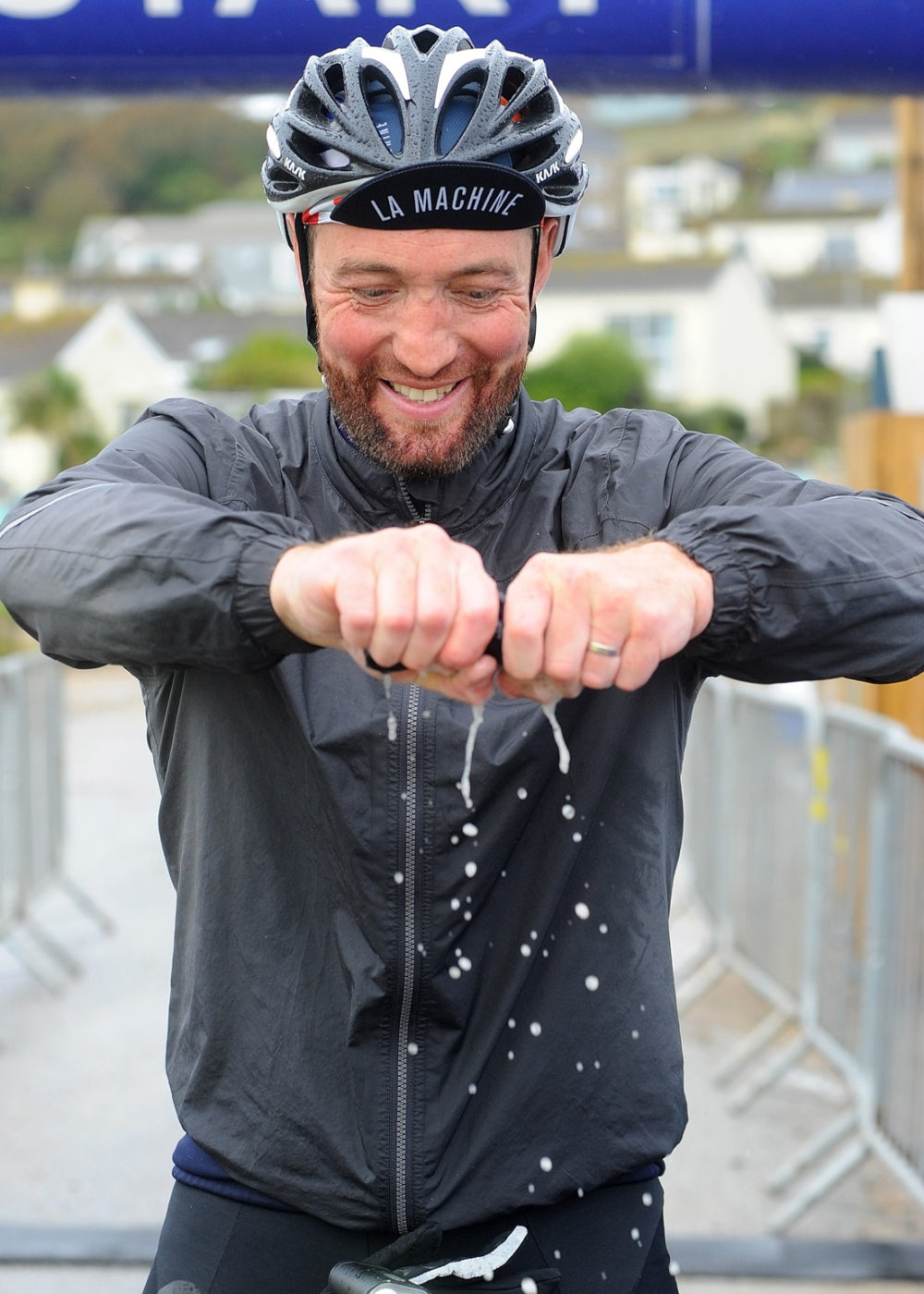How to take photographs in the rain. All photographs © Al Macphee/MiraclePR
This week I covered the Sportiva Lands End 100 and the forecast for the event was 95% chance of heavy rain. In Cornwall, with the weather coming in from the Atlantic, you can expect wet weather in Autumn.
Because my brief was to shoot the race starts, it would mean standing at a single location for more than an hour. There were around 350 entrants registered so with staggering the different age groups, abilities and routes it did take a while to set them off and for them to cycle past me.
Bearing in mind that we were starting on the coast and I was facing the beach, the chances of rain blowing into the lenses was pretty good. The first sections started at 8am and the last 9.15am. That’s a long time to stand with a high percentage of heavy rain.
The logistics included good, fully charged batteries; large, formatted memory cards – because you don’t want to mess around opening up your camera and changing memory cards in the rain – and wrapping your equipment up in waterproof casings.
Set your equipment up beforehand. I wear glasses for reading so obviously with rain, reading menus on the back of cameras to change ISOs etc. is not easy. Get that sorted out beforehand.
Get there nice and early so you have enough time to get changed on arrival rather than driving with an extra layer. Then get wrapped up in your waterproof clothes. If you are wearing waterproof trousers you can always take them off and hang them over the back of the car if it eases off. If you can’t get hold of waterproof trousers, take several changes of clothing for that kind of forecast.
For the Lands End 100, the first entrants leave at 8am and the last finishers might be coming back around half past five in the evening. That’s a long time to be standing around in a pair of wet jeans.
Wear a good pair of comfortable driving shoes too. You don’t want to be driving five hours in heavy waterproof boots.
Changing routes
As it happened, the forecast was spot on. So, I got drenched in the morning and had breakfast with coffee in the car to dry off between sections. The first lot were doing a short route and, based on the previous year, the earliest I could expect the first finisher was about 11am. So that theoretically gave me between 9 and 11 to have breakfast, get dried out and get set up for the finishing line shots.
Now, the Land’s End 100 includes a short, medium and long route. In theory, the short route riders finish first followed by the medium route riders and then the long route riders come in last, from around two in the afternoon. It didn’t work out that way because a lot of riders on the longer routes were getting to the checkpoints and saying, “I’ve had enough of this rain. Can you tell the co-ordinator and safety people that I’m going to drop down to the shorter route?”
So we were getting a call every five or ten minutes to say, “Number 272 is changing to the medium route,” etc. It was a logistical nightmare. The poor timing guy with the medals was just going nuts. He was doing very well but he was getting a little bit annoyed. I can’t say I blame the riders though. It was wet and miserable and the visibility was awful.
I’ve got adapted ‘hands-free’ brolley holders but because the rain was more or less horizontal, brolleys were useless. So, I pulled the car up, near to the finishing line and used a reasonably long lens so I could leave a safety route for the bikes.
So we just had to keep our eyes and ears open for anyone coming down to that finishing line. The first rider came in at about quarter to eleven which caught me out a bit. He had switched from the medium route to the short and was a bit faster than everybody else.

It was hammering it down so you couldn’t really take cover anywhere and still keep an eye on the route. What I ended up doing was moving the car to the finish line and shooting out of the window, using that as a brolley. I’ve got adapted ‘hands-free’ brolley holders but because the rain was more or less horizontal and it was windy, brolleys were useless. They would just blow over. So, I pulled the car up, near to the finishing line and used a reasonably long lens so I could leave a safety route for the bikes to get around me and over to the timing guy and then on to the presentations area for their medals and goodie bags.
Fluid balance
Planning loo breaks is important. This directly relates to your fluid intake. There’s a problem there, because if you’re drinking tea and coffee to keep you warm, you’ve got to get rid of it somehow. Bear in mind that I’ve been up since two or three o’clock, had a cup of coffee to focus myself for driving, a couple of cups of coffee when I’ve got to the event and a few more drinks throughout the day to keep me going. But, at four o’clock in the afternoon I am not going to be able to go to the loo, because the riders will be coming in thick and fast!
So, you’ve got to limit your fluid intake. Even though you shouldn’t really, logistics dictate that you must. You might think you’ve got a break and you can sit there for ten minutes without a bike coming through. But the minute you go off that spot, sod’s law someone will come through. The race timer had the same issue but he had cover. I was the only person who could use my equipment and it was not worth paying a second shooter just to cover ten minutes every four hours.
You might think you’ve got a break and you can sit there for ten minutes without a bike coming through. But the minute you go off that spot, sod’s law someone will come through
If you have to take a loo break, make sure you can see the approach to the finish line and keep an eye on who’s coming through, the colour of the jersey, the numbers if possible. I went to the loo twice that afternoon. The loo was three minutes away. By the time I got back to my car and retrieved my equipment, that’s ten minutes. Twice I missed people coming through.
If you do miss a competitor and you’ve got that brief to get a shot of everyone finishing, the easiest way is to note the colour of the competitor’s jersey and approach them afterwards once they’ve got their medal. Be honest with them. Say, “Excuse me mate, I went to the loo and missed you. When you get your breath back, can you stand in front of the Mount for a photograph?”
Anyway, enough about logistics. Let’s return to the topic of how to take photographs in the rain.
HOW TO TAKE PHOTOGRAPHS IN THE RAIN: PRO TIP
If you are trying to sell pictures to people, find something in the background to typify each event. A lot of people at the Land’s End 100 were professional triathletes so a shot going down country lanes could have happened anywhere in the country. Ideally, I would have got the Land’s End sign but they weren’t going down to the actual point. The nearest and most logistical point was St. Michael’s Mount. That location, with the mount in the background, tells the story of the event much more than a hedge.
How to take photographs in the rain: equipment settings
The weather was going to come in towards me from the coast – that was the wind direction. I needed a long lens hood and a reasonably wide lens but I also wanted the ability to change my angle and do something else if needed without the complication of changing lens with wrapped up equipment.
A versatile lens which gives you an aperture of at least f/4 will work wonders in these conditions. Luckily for me, I was able to work on a 28-300mm Nikon and manage on an f/4 aperture just by cranking the ISO up.
Nowadays, you’ve got 36 megapixel cameras which would help with handling the grain but that makes your file sizes too big which in turn makes your buffering too long. If you’ve got 50 odd bikes whipping past you and you’ve got to take over 100 shots more or less consecutively, your buffer is going to slow you down and you could miss the last two or three.
You can use noise reduction software in post-production to lessen the grain by creating more pixels. Or you’ve got the other option of using the grain to add an effect.
HOW TO TAKE PHOTOGRAPHS IN THE RAIN: PRO TIP
Sometimes, if there is a lot of visible mist and rain, preserving the grain and producing the photograph in black and white can create a very atmospheric picture.
Because it was getting very dark, I was shooting at something like 6400 ISO film speed with an f/4 aperture. If you’ve got a bike whipping past you, you would ideally need a 1/500 second shutter speed. If you’re pushing it to get to that speed because of low light, you can knock it down to 1/250 and use panning. For more detail about how aperture, shuttr speed and ISO relate to each other, see my blog post on The Exposure Triangle.
With panning, you’re moving the camera with the bike. You might be blurring the background a little bit but the bike is sharp.
When you’re looking at people wanting to buy pictures as a record of an event they’ve competed in, what they want is a sharp picture, not an arty one. They don’t want the mount sharp while they’re blurred. You’ve got to create what the client wants.
If you have any more questions on how to take photographs in the rain, fill in the form on this page.
Have a burning photography question you would like Al to write about in his next blog post? Email info@miraclepr.com with your request.

